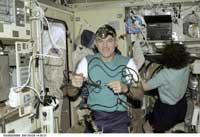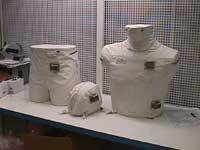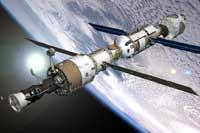Fred, a special astronaut

Fred is a model of a human being, but only in dress and head. It measures 90 centimeters and has a weight of 45 kg. It has artificial skin, real bones and artificial organs that will rotate for four months next to the International Space Station. Fred will be a tool to analyze how strong spatial radiation affects the body of astronauts. Although we know that the ozone layer is weakened, we live perfectly on Earth under the protection of the atmosphere. The sun is getting stronger and the placement of protective creams against skin cancer is fundamental, but this is nothing compared to the radiation circulating through space. And for that there is no cream.
Outside the limits of the atmosphere, astronauts face weightlessness and spatial radiation. This radiation is formed by high-speed particles that can cause great pain when crossing the human body. The most harmful are galactic cosmic rays. These rays are formed by nuclei accelerated by explosions of stellar supernovae, which can be as light as hydrogen or as heavy as iron. The heavier they are, the more harmful they are.

Protons of the most common name are also not slow. They have less energy than galactic cosmic rays and are less harmful, but neither benign. Most are emitted by the Sun and when a solar eruption occurs they reach astronauts at very high concentrations. Then they can be very dangerous.
If this were not enough, astronauts orbiting the Earth should also consider a third source of radiation, the South Atlantic Anomaly, located in the upper part of the Brazilian coast. In this region the galactic cosmic rays trapped by the Earth accumulate, a fast-paced region. However, if the South Atlantic Anomaly crosses in less than 20 minutes, it is estimated that the body is able to repair the damage caused by radiation. The problem is that the International Space Station crosses this region five times a day and takes about 22 minutes to do so.
Astronaut risks

A construction like the International Space Station suffers a constant bombardment of galactic cosmic rays and protons and, five times a day, the Anomaly of Brazil. Due to radiation, satellites, probes and vessels can suffer energy losses, failures and failures in electronic systems and leave all the amount of money dissipated in nothingness. Therefore, everything that moves into space is protected against radiation, theoretically also astronauts. High doses of radiation can cause cell death and tissue damage, and in the worst case can cause cancer, cataract, and nervous system alterations.
They say that the inhabitants of the International Space Station receive very small doses of radiation and, as the Americans have repeated over and over again, none of their astronauts have suffered from space-related diseases. Scientists have been researching cosmic radiations since 1940 and since man is able to travel into space, a multitude of experiments have been conducted to see how they affect living beings. The Russian station Mir, for example, has taught a lot to the International Space Station.

However, all measurements made so far have been based on stays of a few months and only the skin has been investigated. The response of internal organs to radiation has not been analyzed, although it is most important. To determine the dangerous dose of radiation it is necessary to know how it affects the brain, heart, lungs, liver... as it is in these organs where cancers occur.
The International Space Station will study for the first time the relationship between spatial radiation and internal body organs, thanks among other things to Fred. The intracorporeal propagation of radiation will be measured and the project managers have stated that the results will serve to complete the appropriate model for each astronaut. The height, weight and personal history of each astronaut greatly condition the dose of radiation that the internal organs will receive. For example, displacement within the astronaut station may vary the dose received.
Fred will be floating outside the station for four months, as in astronaut rides outside the station, as astronauts receive the most radiation when they work outside the station. Within four months it will be transferred to Earth and an analysis of the data collected in the sensors will be carried out. In addition to this NASA project, Germany and Japan will conduct another study to measure the degree of radiation inside the station.

In the medium term, these research will be very useful for planning a possible trip to Mars. And, at least with current technology, astronauts will have to make a space excursion of about three years to make a trip to Mars and study something there, which means a lot of radiation. NASA is keen to announce and, as you can see, prepare its journey to Mars. As on other occasions, we hope that space research will also contribute to Earth.
Published in 7K
Buletina
Bidali zure helbide elektronikoa eta jaso asteroko buletina zure sarrera-ontzian











